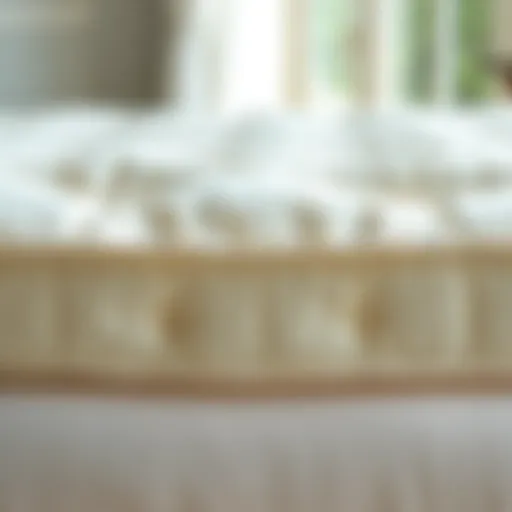Benjamin Moore Kitchen and Bath vs Aura Paints Analysis
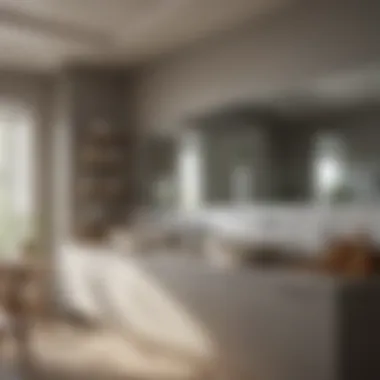
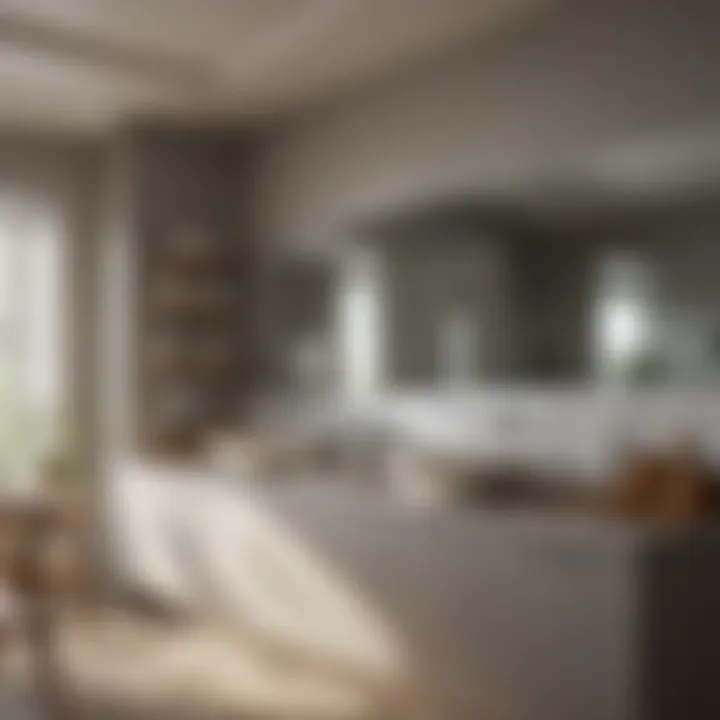
Intro
Choosing the right paint for your home improvement project, especially in areas like kitchens and bathrooms, is crucial. The paint you select significantly affects how the space looks and resists moisture and wear. This analysis will focus on two prominent paint options from Benjamin Moore: Kitchen and Bath paints and Aura paints. Each has its own distinct features worth examining.
In this article, we will detail a range of factors including their formulations, application techniques, and durability. We will also discuss the suitability of each type for various environments, enabling you to make informed purchasing decisions. Additionally, pricing, color options, and environmental impact will also be evaluated, ensuring a comprehensive understanding of what each option entails. Let’s start by diving into the materials required for a DIY painting project.
Prelims to Benjamin Moore Paints
In any discussion about paint, it is essential to consider the brand at the forefront of quality and innovation. Benjamin Moore has established itself as a prominent player in the paint industry. This section will provide a closer look at who they are, their notable products, and the reputation they hold among consumers. Understanding this brand is vital for making informed decisions regarding kitchen and bath paints versus their Aura line.
Brief Overview of the Brand
Benjamin Moore has been in operation since 1883 and has built a legacy based on quality and reliability. The brand is known for its extensive range of colors and finishes. Their products cater to various needs, from residential homeowners to professional contractors. Benjamin Moore emphasizes sustainability and incorporates environmentally friendly practices into its formulations. Their commitment to quality assures users that they are investing in products that enhance interior and exterior spaces alike.
History and Reputation in the Paint Industry
The history of Benjamin Moore paints is a testament to its enduring reputation. Originally founded by the Moore brothers in New Jersey, the company rapidly grew due to its high standards for production and customer service. Over the decades, Benjamin Moore has adapted to changing trends and customer preferences. Today, the brand is celebrated not just for its range of colors but also for its innovation.
Reputation is a critical aspect of Benjamin Moore’s identity. They have consistently received awards for their products, largely due to their commitment to quality and customer satisfaction. Homeowners and professionals alike trust Benjamin Moore paints across various applications. Their Kitchen and Bath paint is well-regarded for its durability and moisture resistance, making it a reliable choice for high-humidity environments. Overall, the brand's combination of history, quality, and innovation positions it uniquely within the market.
Understanding Kitchen and Bath Paint
Understanding the specific requirements of kitchen and bath paints is essential when considering your home improvement projects. These areas in the home are particularly prone to moisture, stains, and frequent cleaning, making their paint demands distinct from other rooms. It’s crucial to analyze how various paints perform under these conditions to ensure longevity and aesthetic appeal.
Unique Characteristics of Kitchen and Bath Paint
Kitchen and bath paints are formulated to withstand unique challenges. They should offer resistance to moisture and humidity, which are prevalent in these environments. These paints provide a smooth finish that is easy to clean, an important feature as these areas can accumulate grease and grime.
Moreover, the finish of kitchen and bath paints is often semi-gloss or satin, providing a level of sheen that not only enhances the look but also protects the surface from wear and stains. This level of sheen can reflect light, making spaces feel brighter and more spacious.
Formulation and Ingredients
The formulation of kitchen and bath paints typically involves specialized ingredients that provide water resistance. Many of these paints include anti-microbial properties, which help inhibit the growth of mold and mildew. This is particularly important in bathrooms where humidity can promote such growth.
These paints often use high-quality resins and pigments to ensure durability. The use of lower-VOC (volatile organic compounds) formulations is also common. This feature is beneficial in reducing harmful emissions, contributing to a healthier indoor environment. This is important not just for the aesthetics of the paint but also for the well-being of the household.
Recommended Areas of Use
While kitchen and bath paints are specially designed for high-moisture areas, their capabilities can extend beyond these rooms as well. They can be effectively used in mudrooms or laundry areas that experience moisture and dirt.
When selecting areas for application, it’s wise to consider space that demands durability and resistance to frequent cleaning. Additionally, areas that might see spills or varying temperatures, such as near stoves or sinks, are also recommended for the use of such specialized paints.
Examining Aura Paint
Examining Aura paint is essential in understanding its role in home improvement projects. Known for its unique technology, Aura paint offers an array of benefits that distinguish it from other products in the Benjamin Moore line. Homeowners often seek options that promise both aesthetic appeal and durability, especially for spaces such as kitchens and bathrooms that witness higher wear over time. In this section, we will delve into the specific elements that make Aura paint a compelling choice for many users, emphasizing its application methods and overall effectiveness.
Overview of Aura Paint Technology
Aura paint is engineered with advanced technology designed to enhance its performance across various surfaces. One key aspect of Aura is its Color Lock technology, which helps maintain the vibrancy of colors longer than traditional paints. This technology enables the paint to form a smooth, uniform surface that resists fading, thus enhancing the overall look of any room.
Additionally, Aura is a self-priming paint. This means that it can adhere directly to a variety of surfaces without requiring a separate primer. This feature not only reduces the amount of prep work needed, but it also saves time during the application process. The ease of use makes it appealing for homeowners who may not have extensive experience in painting.
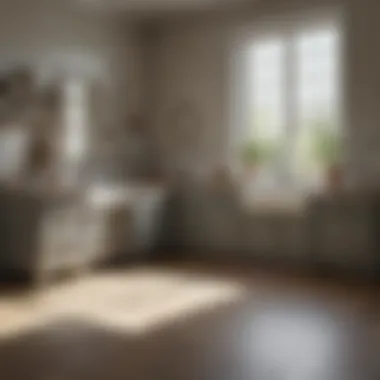
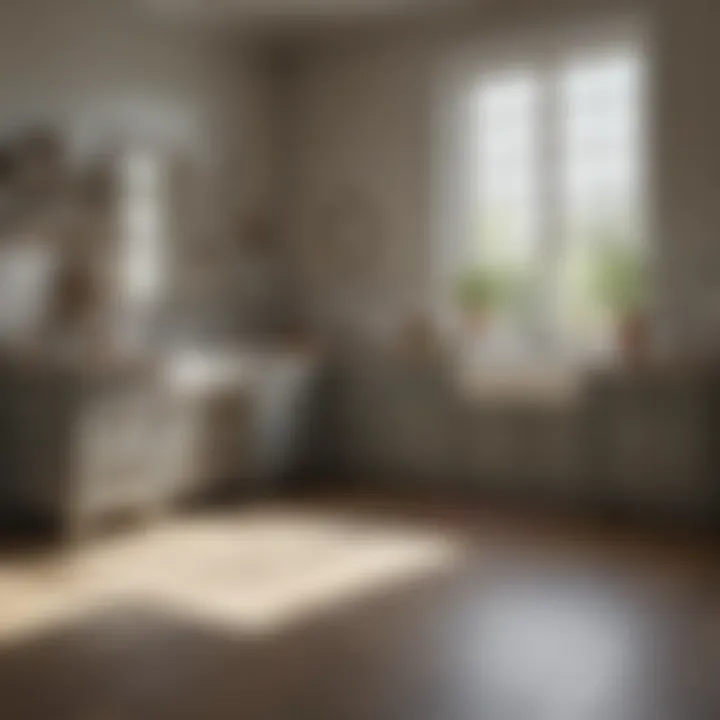
Key Features and Benefits
Aura paint possesses several notable features that cater to the needs of homeowners:
- Rich Color Selection: Aura provides a wide range of colors, allowing for almost limitless customization for any interior.
- Fast Drying Time: This paint dries quickly, which minimizes the waiting period between coats and enables quicker project completion.
- Excellent Coverage: Aura offers impressive coverage in just one or two coats, reducing the amount of paint needed and associated costs.
- Stain Resistance: Its formulation includes qualities that resist stains and make cleaning easier, a crucial factor for kitchen and bath surfaces.
The benefits associated with Aura paint extend beyond aesthetics. The self-priming nature combined with its durability ensures that the paint maintains its look for years.
Durability and Longevity
Durability is critical for any paint, especially in environments where moisture and wear are common. Aura paints are designed to withstand the rigors of daily life. Its resistance to mold and mildew further solidifies its position as a favorable choice for kitchens and bathrooms. Regular cleaning does not impact the finish adversely; rather, the paint maintains its appearance with minimal maintenance.
"Distinctly engineered to last, Aura paint transforms surfaces into lasting impressions that withstand the test of time."
Homeowners often report that Aura paint retains its look and feel for extended periods, making it a cost-effective solution in the long run. The combination of its rich palette and robust performance signifies that Aura paint meets high standards for both functionality and style in the home. With these qualities in mind, it is clear why many choose Aura for their painting needs.
Performance Comparison
When choosing paint for kitchen and bath areas, performance is a critical aspect to consider. The right paint needs to not only adhere well but also withstand the unique challenges of moisture, stains, and regular cleaning. In this analysis, we examine specific factors that contribute to the performance of Benjamin Moore's Kitchen and Bath paints compared to Aura paints. The emphasis is on three significant elements: coverage and application process, drying time and touch-up capability, and resistance to moisture and stains. Each of these factors plays a vital role in ensuring that the paint job is both aesthetically pleasing and durable over time.
Coverage and Application Process
Coverage defines how far a paint can stretch and how effectively it can mask the underlying surface. Benjamin Moore's Kitchen and Bath paint is known for its excellent coverage, often requiring fewer coats than some competitors. This can lead to savings in both time and material costs. However, the application process should also be considered; thick or viscous paints can be more challenging to apply, especially for DIYers.
Aura paint, on the other hand, boasts its own unique advantages. The paint exhibits exceptional flow and leveling, producing a smooth finish. Homeowners often find that applying Aura paint is straightforward, whether it is brushed or rolled. These factors make both paint types essential choices depending on the project's needs.
Drying Time and Touch-up Capability
Drying time is another important consideration. Kitchen and Bath paints typically dry quickly, allowing for faster project completion. Benjamin Moore's options can dry to the touch in as little as one hour, which is crucial for busy householders who need spaces ready for use again. However, the quick-drying nature can complicate touch-ups if assistance is necessary.
Aura paint also excels in drying times. While it dries quickly, it retains the ability for touch-ups without noticeable defects. Homeowners can feel more confident correcting minor imperfections without sacrificing the overall finish.
Resistance to Moisture and Stains
Perhaps the most critical factor is the paint's resistance to moisture and stains. Kitchens and bathrooms are exposed to high humidity and spills, making it essential for paint to guard against mold and mildew growth. Benjamin Moore's Kitchen and Bath paints contain mildew-resistant properties, reinforcing long-term durability in these environments.
Aura paint also offers robust resistance to moisture, in addition to a stain-repellent formulation. This makes cleaning much easier, as stains do not penetrate the surface as readily. Overall, both types provide solid performance in combating challenges associated with kitchens and baths.
"Choosing the right paint requires an understanding of performance factors that go beyond mere aesthetics."
Color and Aesthetic Options
Understanding color and aesthetic options is essential when choosing paint for your kitchen and bathroom. Both spaces are often at the forefront of home design, where personalization meets practicality. Selecting the right colors can significantly influence the atmosphere and functionality of these areas.
Color Palette Diversity
Benjamin Moore offers a wide variety of colors for their Kitchen and Bath paints. The color palette is crucial because it can enhance the overall feel of the space. Popular colors for kitchens often include soft whites, muted grays, and rich blues. In bathrooms, lighter shades tend to create a sense of spaciousness, while deeper tones can add an element of luxury.
Prospective buyers will find that the range of colors allows for creativity and adaptability. Here are some characteristics of the color options:
- Trendy Choices: Seasonal color trends affect homeowner decisions, ensuring that the colors remain fresh and modern.
- Timeless Classics: Classic colors can complement various decor styles, making them a reliable choice.
- Bold Statements: For those looking to express individuality, vibrant colors and unique finishes allow for distinctive designs.
On the other hand, Aura paints also feature an extensive color selection. They are recognized for their depth and clarity, ensuring that the chosen shades come alive once applied. The selection process benefits homeowners by giving them the freedom to create a cohesive look throughout their homes.

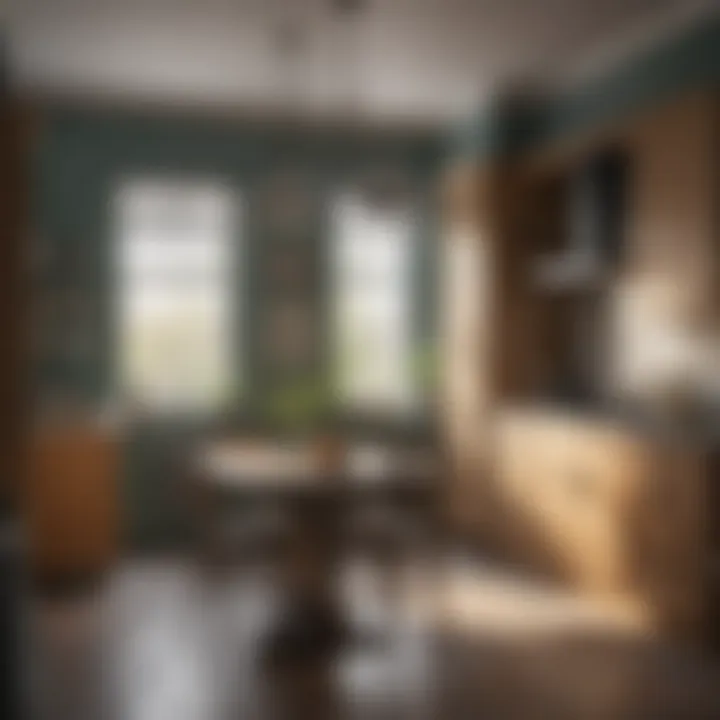
Customization Possibilities
Customization is a significant asset of Benjamin Moore paints. Many homeowners desire a specific shade that may not be readily available. This is where the capability to create custom colors becomes essential. Benjamin Moore can mix paints to achieve nearly any color the consumer can envision. This feature caters specifically to those looking for a unique touch in their home.
Aura paints, while also rich in color options, limit customization compared to Kitchen and Bath paints. However, they excel in offering finishes that enhance the paint's performance. Consumers should consider the potential need for custom mixing, particularly if they have an aesthetic vision that differs from standard offerings.
"The color palette not only represents personal taste but also impacts the functionality and mood of spaces like kitchens and bathrooms."
This analysis highlights the importance of color and aesthetic options in paint selection. Understanding the available choices and customization options allows homeowners to create personalized environments tailored to their specific desires.
Environmental Considerations
The choice of paint goes beyond aesthetics and durability; environmental considerations are becoming increasingly crucial for homeowners and builders! With a growing awareness of the impact of volatile organic compounds (VOCs) and sustainability, selecting paint that is friendly to both health and the environment is essential. This section focuses on two significant aspects of the Benjamin Moore Kitchen and Bath paints and Aura paints: their VOC levels and the environmental sustainability practices each brand employs.
Low-VOC and Eco-Friendly Options
When selecting paint for interior spaces, especially kitchens and bathrooms, understanding VOCs is crucial. VOCs are chemicals that can evaporate and contribute to air pollution, potentially causing health problems. Therefore, low-VOC options can significantly enhance indoor air quality and reduce exposure to harmful substances.
Benjamin Moore offers a variety of low-VOC and eco-friendly paint choices. Their Kitchen and Bath paint line includes products that adhere to strict environmental standards. These formulations not only ensure minimal odorous emissions during and after application but also focus on maintaining a healthier indoor environment. This is particularly advantageous for homes with children, pets, and individuals with respiratory issues.
Additionally, Aura paints are notable for their low-VOC formulations. They are designed to provide exceptional coverage while still being safe to use in enclosed spaces. Both lines assist in mitigating unpleasant odors, allowing for quicker reoccupation of painted areas.
In summary, selecting low-VOC and eco-friendly paints is valuable for maintaining a healthy living space. Homeowners looking for sustainable solutions will especially appreciate these options.
Sustainability Practices of Benjamin Moore
Benjamin Moore takes its environmental responsibility seriously. The brand engages in several sustainability practices that extend beyond just creating low-VOC paints. The company actively invests in reducing its carbon footprint and resource consumption during the manufacturing process.
For instance, Benjamin Moore has committed to conserving water, optimizing energy use, and minimizing waste. This commitment reflects a broader strategy that prioritizes sustainable production. Their facilities utilize advanced technology aimed at reducing emissions and improving overall efficiency.
Additionally, the company embraces the concept of green-building certifications, aligning its products with standards such as LEED (Leadership in Energy and Environmental Design). This allows homeowners to confidently choose Benjamin Moore products, knowing they support sustainability in construction and renovation.
Moreover, the brand strives to promote recycling and responsible disposal practices among consumers. By encouraging the recycling of leftover paint and utilizing eco-friendly packaging, Benjamin Moore demonstrates a proactive approach to environmental stewardship.
Cost Analysis
Cost analysis plays a crucial role in determining the best choice between Benjamin Moore's Kitchen and Bath paints and Aura paints. Given that home improvement projects often have budget constraints, understanding pricing structures, potential expenditures, and overall value becomes essential. It helps consumers make informed decisions, aligning their preferences with their financial capabilities. This section will examine how each product stands in terms of cost versus performance, ensuring that house owners and housewives can achieve their desired results without overspending.
Pricing Structures of Kitchen and Bath vs Aura
When looking at the pricing of Benjamin Moore's Kitchen and Bath paints compared to Aura paints, several elements need consideration. Benjamin Moore’s Kitchen and Bath paints generally come at a mid-range price point, while Aura paints are positioned at a higher price segment. The price difference can be attributed to the technology and formulation each paint uses.
For example, Kitchen and Bath paints are designed specifically for areas with high humidity and frequent cleaning. They tend to have lower durability over time but are formulated to protect against moisture and mildew. On the other hand, Aura paints, known for their superior covering ability and long-lasting finish, justify their higher price with a more advanced formula.
Some price ranges to expect include:
- Benjamin Moore Kitchen and Bath Paints: Approximately $30 - $50 per gallon.
- Aura Paints: Approximately $60 - $80 per gallon.
This discrepancy in pricing necessitates a careful evaluation of which factors are most important to the individual consumer.
Value Proposition and Cost-Effectiveness
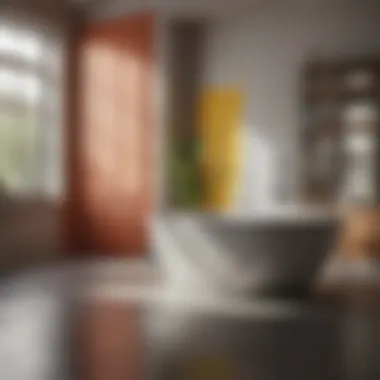
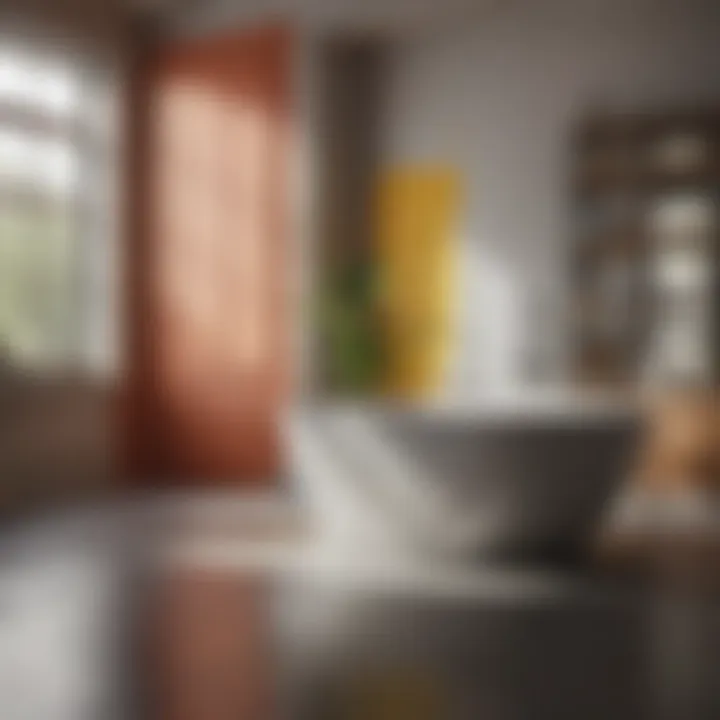
Understanding value proposition is essential to making an effective comparison between these paint options. While the upfront cost of Aura might deter some, its long-lasting quality can result in lower costs over time. The durability of Aura paints often leads to fewer repaints and potential savings in maintenance costs.
In contrast, while Benjamin Moore’s Kitchen and Bath paints may be less expensive, they might require more frequent touch-ups or repaints, particularly in high-traffic or moist areas. In making a decision, consider the following points:
- Durability: Aura’s robust formulation often stands the test of time better than Kitchen and Bath paints.
- Application: Less number of coats needed with Aura can reduce labor costs.
- Maintenance: Lower maintenance frequency for higher-priced paint can lead to cost savings in the long term.
Ultimately, a lot depends on the specific needs of the homeowner. Choosing the right paint is not just about initial price but also about long-term value. Both products have their unique advantages; understanding these is key to making the best choice for your home.
Customer Reviews and Feedback
Understanding customer reviews and feedback is essential in evaluating the performance of Benjamin Moore's Kitchen and Bath paints and Aura paints. These insights provide prospective buyers with valuable information about real-world experiences, which can influence their purchasing decisions. Reviews often highlight the strengths and weaknesses of the products, shedding light on their true durability, ease of application, and overall satisfaction. They serve as a bridge between the manufacturer’s claims and actual consumer experiences, thus enhancing the decision-making process.
Through customer feedback, home owners can gauge how paints, like those from Benjamin Moore, perform under specific conditions. Positive reviews can indicate reliability and quality, while negative ones alert potential buyers to shortcomings. Furthermore, knowing which features customers appreciate helps readers make more informed choices aligned with their needs and expectations.
In essence, customer reviews encapsulate practical insights that are often missing from promotional materials, making them indispensable in a thoughtful comparison.
Consumer Satisfaction Metrics
Consumer satisfaction metrics provide quantitative data derived from customer feedback. They often include ratings and scores based on product performance and user experiences. For Benjamin Moore’s Kitchen and Bath paints, users generally report satisfaction in key areas such as:
- Coverage: Many customers note how efficiently the paint covers surfaces, often requiring fewer coats than competing brands.
- Finish: Reviews commonly praise the variety of finishes available, allowing personalization and aesthetic adaptability.
- Ease of Application: Many customers emphasize how straightforward the application process can be, which often translates to a smoother experience for DIY projects.
- Durability: Buyers frequently mention the long-lasting quality of the paints, especially in moisture-prone areas like kitchens and bathrooms.
For Aura paints, metrics often reflect similar strengths but with additional notes on advanced technology that supports ease of touch-ups and rapid drying times.
Common Complaints and Praises
In customer reviews, both complaints and praises become a focal point of scrutiny.
Common Praises:
- Color Variability: Users often highlight the diverse color options available, allowing homeowners to find precisely what they envision for their spaces.
- Sustainability: Many appreciate the low-VOC formulas, recognizing the environmental advantages and health safety components.
- Longevity: Consumers frequently report less frequent repainting due to the product's resilience to wear and tear.
Common Complaints:
- Price Point: Some users express concerns about the cost, indicating that premium pricing may limit accessibility for budget-conscious homeowners.
- Drying Issues: Occasional complaints surface regarding the drying time being longer than expected, particularly under certain conditions.
- Application Challenges: While many find the application easy, a segment of users notes challenges, such as roller marks, particularly with darker colors.
The interplay of praises and complaints creates a nuanced understanding of the practical benefits and potential drawbacks of both Benjamin Moore's Kitchen and Bath paints and Aura paints. Engaging with these insights is crucial for homeowners aiming to make the most informed choices for their specific needs.
End
The conclusion of this article holds significant relevance as it encapsulates the exploration of Benjamin Moore’s Kitchen and Bath paints in comparison to Aura paints. This section distills the critical aspects examined in previous sections, providing a final perspective on the features, benefits, and applications of both paint types. By summarizing key findings, it helps readers synthesize the information, making it easier to internalize the nuances involved in selecting the right paint for their specific needs.
Summarizing Key Findings
In the analysis, several distinguishing features emerged. First, Benjamin Moore's Kitchen and Bath paints are expertly formulated to resist moisture and stains, making them ideal for high-humidity areas. Their unique ingredients offer durability and washability, ensuring long-lasting results in kitchens and bathrooms, where wear and tear are common. On the other hand, Aura paints are recognized for their exceptional color retention and coverage, proving to be a robust choice for various indoor applications.
Moreover, both options present an array of color palettes, allowing homeowners to explore creative possibilities. However, Aura paints often stand out due to their rich and vibrant colors, which appeal to those looking for a more distinguished aesthetic.
Cost analysis indicates that Benjamin Moore’s Kitchen and Bath paints tend to be more budget-friendly than Aura paints. However, the latter may justify its price with superior performance and longevity.
Making an Informed Decision
To make an informed decision, homeowners need to analyze their specific requirements before selecting between Benjamin Moore’s Kitchen and Bath paints and Aura paints. Important considerations include the environment of application, the anticipated wear on the painted surfaces, and the desired aesthetic outcome. For spaces prone to high moisture, such as bathrooms, Benjamin Moore's offerings could be more suitable.
Conversely, if a homeowner seeks paints that provide a rich and lasting finish with a variety of color options, Aura paints might be the ideal choice despite their higher price point. Ultimately, making a well-informed choice involves understanding both the functional attributes and personal preferences that define each product’s appeal.
"Choosing the right paint is not merely about color; it also encompasses functionality and longevity in your specific environment."
In summary, this conclusion serves as a valuable insight into the comparative analysis, highlighting the necessity for thoughtful consideration when selecting paints in home improvement projects.







